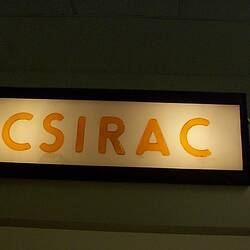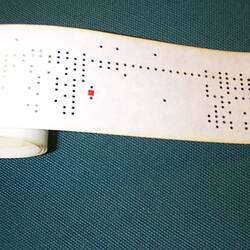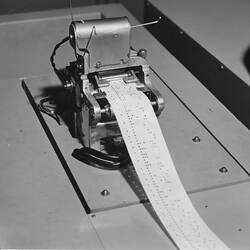Summary
Equipment set up to read archival CSIRAC Computer paper tapes and save the information in electronic form. The equipment was assembled in 1997, long after CSIRAC ceased all operations in 1964. Paper tapes were read by CSIRAC using paper tape readers of a different design.
The equipment consists of a late 1980s laptop computer connected to a computer printer (circa 1985) via a parallel interface. It is still operational and has been used occasionally to read CSIRAC paper tapes. A video was made in 2009 showing a paper tape being read.
Reading the tapes required a mechanism for advancing the tape in a controlled manner and a means of reading the holes on the tape. The Apple printer platen was used to advance the tape, under control of the software (written by John Horvath) executed on the Toshiba Laptop computer. The holes in the tape were detected photo electrically with a light detection system mounted on the printer.
A project to re-construct the CSIRAC music was a stimulus for the construction of a system to read CSIRAC paper tapes. The reading of the music tapes was a small part quantitavely of the tape reading project. The paper tape reading equipment was used by John Spencer and Jurij Semkiw to read the Melbourne music tapes for the project to recreate CSIRAC music.
Once read, the information on the paper tapes was converted into Hex files, which were converted to CVT format for use with the CSIRAC emulator. TSP (list) files were also created. The work was completed by John Spencer.
12 Hole Paper Tape, number T916 (HT 13509.117), is used to test the tape reader. It should be loaded at a pencil mark drawn on the tape.
The archival paper tape reading equipment consists of:
1. Toshiba laptop Model # T1200, 1987.
Used to drive the converted Apple printer to read 12 hole paper tapes and store the data on 3½ inch floppy disks. The software was written by John Horvath, University of Melbourne.
(The resulting Hex files were converted to CVT format for use with the CSIRAC emulator. TSP (list) files were also created. The work was completed by John Spencer.)
This laptop only reads double density disks, not high density.
Note: power supply unit (16.4V) not supplied
2. Apple Printer Model # A9M0303P, about 1985.
Converted to read CSIRAC 12 hole paper tape and connected via a parallel interface to a Toshiba laptop; the conversion was carried by Jurij Semkiw and John Horvath at the University of Melbourne.
3. Other items
power supply unit (16.4V) for reader mechanism, about 1990
Toshiba AC adaptor
voltage dropping resistor
serial cable (white 6 core)
parallel cable (grey 20 strand)
Power cable for printer
Two 3½" floppy disks in laptop
Laptop carrying case
Toshiba MS-Dos manual
User manual
One systems disk in a case
One diagnostic disk in a case
Unlabelled disk
The set-up and operation of the archival paper tape reading equipment at the University of Melbourne is demonstrating in the short documentary film:
HT 56716, Digital Film - 'Overcoming Obsolescence: Reading paper tapes on CSIRAC, Australia's first computer, 1949-1964'
Physical Description
1. Apple Printer Model Cream oblong machine with attachment to read paper tapes Printer has plastic dust cover 2. Toshiba laptop Model # T1200 Cream laptop with collapsible screen 3. Other items supplied power supply unit (16.4V) for reader mechanism Grey plastic box with cable and power pins 4. Toshiba AC adaptor for laptop Black plastic box with two cable connectors 5. Voltage dropping resistor Black plastic box with two sockets 6. Serial cable white 6 core round cable 7. Parallel cable grey 20 conductor ribbon cable 8. Power cable for printer black mains cable 9. 3½" floppy disks in container 10. 3½" floppy disks in container 10. Floppy disks in laptop A drive 11. Floppy disk in latop B drive
Significance
The paper tape reading project is significant in that it is an example of how obsolete computing software can be read by later non-compatible computing equipment.
More Information
-
Collection Names
-
Collecting Areas
-
Acquisition Information
Donation
-
User
Computer Science & Software Engineering Department, University of Melbourne (The), Melbourne, Victoria, Australia, 1997-2002
-
User
CSIRAC History Team, Melbourne, Victoria, Australia, 1997-2002
-
Recording Details
-
Inscriptions
1. Apple Printer Model # A9M0303P Serial # 701127 2. Toshiba laptop Model # PA7044EA W T1200: Serial # 07914796 3. power supply unit for reader mechanism Panasonic AC adaptor: Model # KX-A11BA 4. Toshiba AC adaptor for laptop Model # PA7485EA: Serial # G9D0707CD 5. Voltage dropping resistor - No inscription 6. Serial cable - No inscription 7. Parallel cable - No inscription 8. Power cable for printer - No inscription 9. 3½" floppy disks in container: Diagnostics and Supplemental 10. 3½" floppy disks in container: MSDOS 3.3 10. Floppy disks in laptop A drive: DOS Boot floppy; 11. Floppy disk in latop B drive: Reader.exe
-
Classification
Computing & calculating, Digital computing, Storage and retrieval
-
Category
-
Discipline
-
Type of item
-
Part Dimensions
310 mm (Length), 303 mm (Width), 80 mm (Depth)
Dimensions of Laptop when closed.
-
Part Dimensions
413 mm (Length), 338 mm (Width), 320 mm (Height)
Dimensions of Printer.
-
Part Dimensions
75 mm (Length), 55 mm (Width), 65 mm (Height)
Dimensions of Power Supply Unit for Paper Tape Reader.
-
Part Dimensions
145 mm (Length), 70 mm (Width), 55 mm (Height)
Dimensions of Power Supply Unit for Laptop.
-
Part Dimensions
85 mm (Length), 55 mm (Width), 55 mm (Height)
Dimensions of Voltage Dropping Resistor.
-
References
[Book] McCann, Doug & Thorne, Peter. 2000. The Last of the First CSIRAC: Australia's First Computer. 196., 2000
-
Keywords
Computer Music, Computers, CSIRAC (Computer), Making History - CSIRAC




